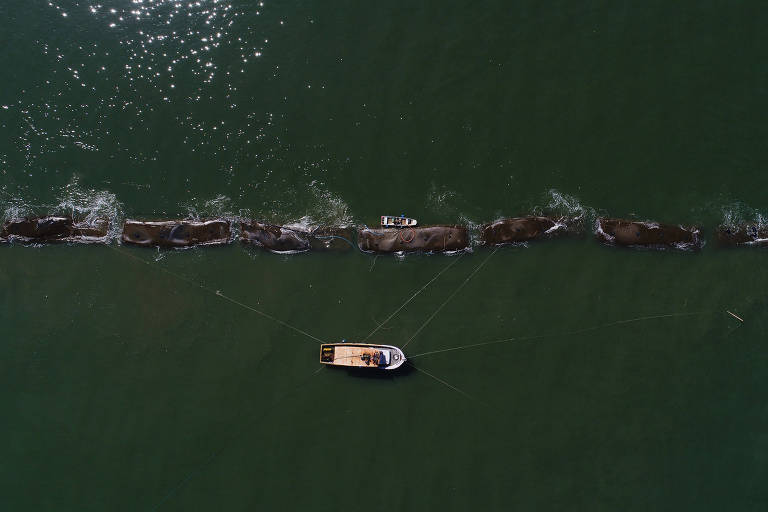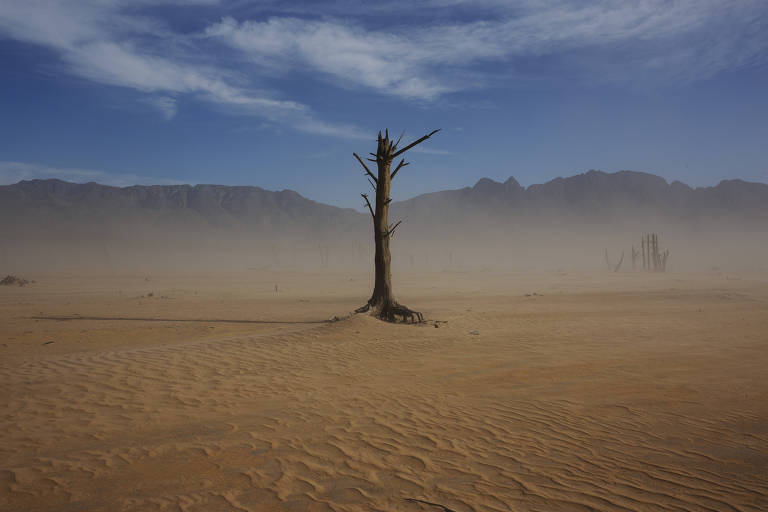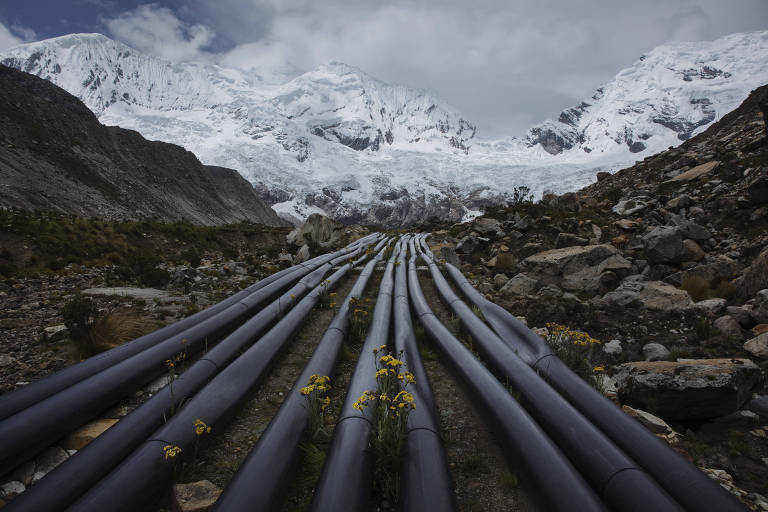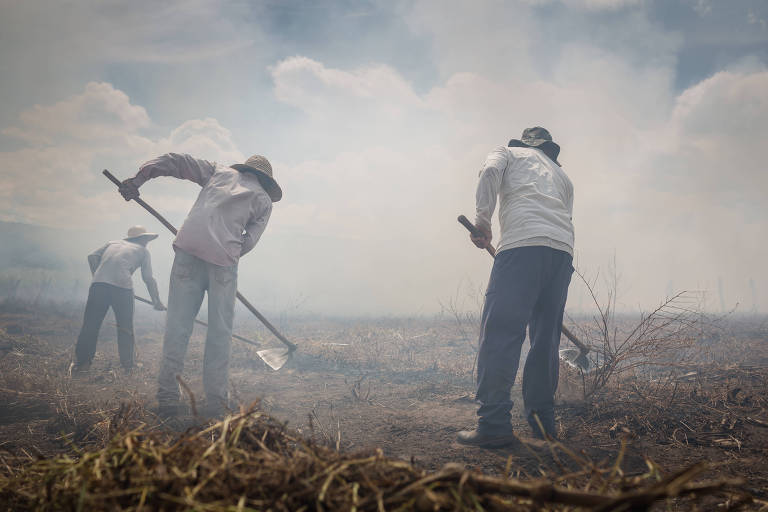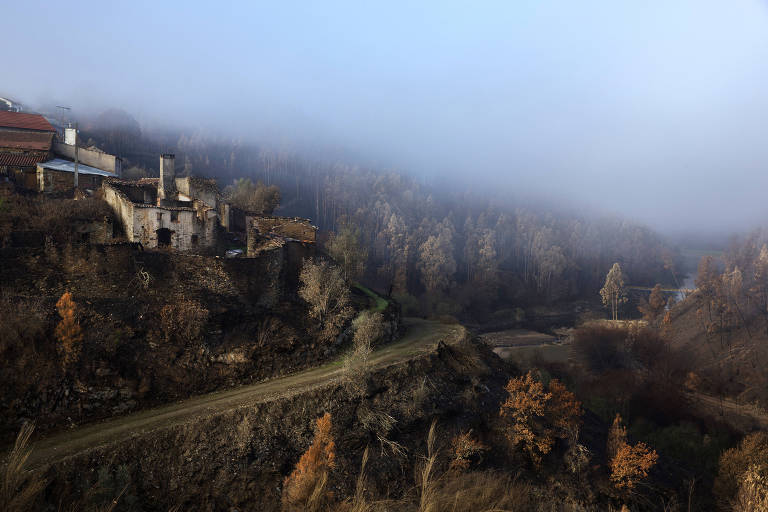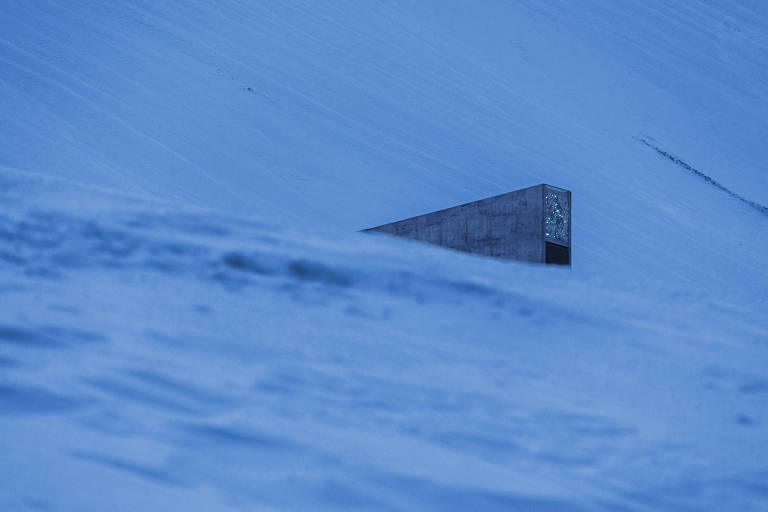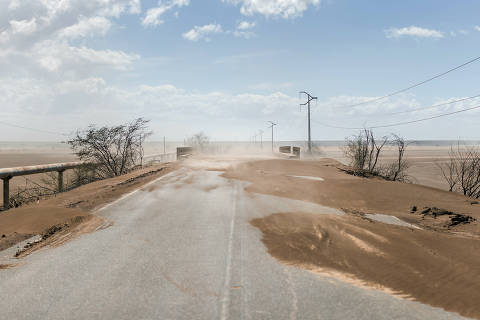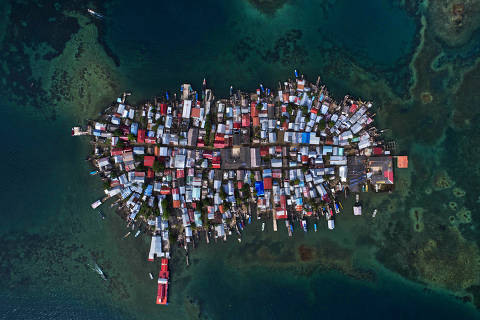Destructive tidal surges and human overpopulation are forcing Panamas indigenous peoples to abandon their islands
22.abr.2018 - 02h00
{{video=1}}
{{lang=1|por,//arte.folha.uol.com.br/ciencia/2018/crise-do-clima/panama/|esp,//staging.arte.folha.com.br/ciencia/2018/crisis-del-clima/panama/}}
It only took a shift in the winds to sense the power of the sea surrounding the 370 islands of the San Blas Archipelago, in Panama's Guna Yala comarca (province). As the wind began gusting from the north, meter-high waves crested above the coral reef off of Devil island (Niadub in the indigenous Guna language). The previously emerald water became clouded with eddying sand, lapping against the coconut trees that provided shade for two dozen tourist cabanas.
The rise in sea levels caused by global warming is not the only challenge the indigenous Guna people are confronting. Sharp population growth (60% from 1920 to 2000), hordes of tourists and disputes with the Panamanian government also threaten the traditional way of island life in this semi-autonomous territory.
Boat pilot Victoriano Martinez, oarsman Edwin Smith and tour guide Rommel Bastidas watched the tide lick their tents, situated near the water's edge. The trio moved them further away without a word. Within minutes the men were at their posts in the fiberglass boat, flying a red and yellow flag emblazoned with an inverted swastika, the symbol of the Onmaggeddummad Sunmmagaled, or Guna General Congress.
{{imagem=1}}
{{imagem=9}}
Their destination was Ant island (Sichirdub), a diminutive outcrop of sand and coral no more than 40 m2. On it stands the thatched hut where 46-year-old Tony Castro Perez lives with his wife and six children three months out of the year.
It seemed as if the islet might vanish under the waves with a change of the wind, but it simply absorbed the blow of the incoming surf. The children who hadn't gone out fishing dodged between the coconut tree trunks and the coral seawall that protects it from erosion.
Castro was out looking for fish among the mangroves of neighboring islands for a four-day festival taking place on Stone island (Aggwadub), where he lives most of the year. Upon noticing the activity on Ant island, he approaches, paddling his canoe. After a few minutes of negotiating with the guide, who produces a tourist license issued by the Guna General Congress, the angler consents to some photos and an interview.
Castro shoots a disdainful glance at the incoming breakers, which were not entering his hut as they had in other storms. "I'm used to the shifting wind and sea," he says. "God gave me this land. I will always live here, and I'll die here. I am not afraid."
{{info=1}}
The fisherman is undaunted by the rise in sea levels predicted by climate scientists. For Guna like him, if the sea rises it is because more fish are being born. "I only believe in God," he affirms. "It's up to Him whether the island will disappear or not."
The change of weather in December, 2017 is no comparison to the storm of November of 2008. That tempest remains vivid in the collective memory of the more than 30,000 inhabitants of Guna Yala, a narrow territory on the Atlantic coast of Panama.
For two weeks, most homes remained flooded. On Crab island (Gardi Sugdub), the archipelago's most populous, the community assembled in the ceremonial seat of the Guna General Congress to pray. Two years later, in 2010, close to 300 families from Sugdub registered to move to the mainland permanently, and are therefore counted among the first to be displaced by climate change.
The populations of many of these islands are stretched to the limit, and some inhabitants are planning a return to continental Panama, which their ancestors fled in the mid-19th century to escape illness –and Spanish colonial rule. Sugdub alone is home to about 2,000 people, subsisting in an area smaller than 10 football fields.
{{info=2}}
The vulnerability of the Guna people is due, in part, to the low altitude of the San Blas islands, which are formed by coral. The sea level along the Caribbean coast of Panama has risen an average of 2mm (.08 inches) per year in the last 100 years, in line with the global average of 1.7mm (.07 inches) per year. Over the past several decades, however, the rate has increased to 6mm (.24 inches) per year.
On average, scientists estimate that global sea levels have risen 20 centimeters (8 inches) since the beginning of the industrial revolution. Much of this is due to thermal expansion of the water as it grows warmer. However, melting glaciers and ice caps are contributing more and more to rising sea levels. This is especially true of glacial melting in the Arctic, the region most affected by global warming and where temperatures are increasing at double the rate of the rest of the world.
The Intergovernmental Panel on Climate Change (IPCC), a body set up by the United Nations and the World Meteorological Organization, predicts a rise in sea levels of between 44 and 74cm (approximately 1 to 2 feet) by the end of this century. A rise of up to 1 meter (roughly 3 feet) cannot be ruled out. This would be enough to flood most coastal cities around the globe and completely wipe clean island nations such as Tuvalu or Kiribati, as well as submerging most of the San Blas archipelago.
{{video=10}}
These IPCC forecasts are considered conservative. Glacial melting is accelerating and, according to the Arctic Council –an international treaty organization founded by Canada, Denmark, the United States, Finland, Iceland, Norway, the United Kingdom and Russia– Greenland alone shed 375 billion tons of ice per year (think of an ice cube with 7 km-long sides) between 2011 and 2014. More recent projections suggest that a sea level rise of 2 meters (6.5 feet) may be more realistic.
The 20 cm (8 inch) rise with a temperature increase of only 1.1° C (1.8° F) may seem trivial, but, coupled with stronger tides and storms –and with strong winds toward the coast– these conditions make for potent and destructive storm surges that accelerate marine erosion.
The Guna use their hands to pack stone, coral rock and even trash, infilling around the edges of the islands in order to battle the constant encroachment of the sea. Instead of safeguarding the islands, however, research indicates that the practice may exacerbate the islands' exposure to the elements and strong Caribbean currents.
The most comprehensive scientific work on the indigenous Guna people and the San Blas islands is a 2003 case study published in the journal Conservation Biology, and led by Héctor Guzmán, a Costa-Rican researcher with the Smithsonian Tropical Research Institute (STRI), in Panama.
{{video=2}}
Based on aerial surveys conducted 30 years earlier, the study determined that the rise in sea levels had submerged 5 hectares (12.4 acres) of uninhabited islands in the archipelago. As if compensating for this loss, landfills had added another 6.2 hectares (15.3 acres) to island communities.
Twenty kilometers (12.4 miles) of seawall were erected, and while this added to the habitable area of the islands, the process was devastating for living coral reefs. In the 1970s, live coral peppered 60% of the archipelago. Since then, that amount has dropped to 13%.
As reefs also act as physical barriers, attenuating wave energy during storms, these epic efforts eventually made the Guna more vulnerable to extreme weather events, such as the rains in November 2008.
Both positive and negative outcomes of the Guna survival strategy can be observed on Fly island (Gugurdub). Surrounded by a 30-centimeter-high (1 foot) coral seawall, much of the ground on the 200 m2 (roughly 2100 square ft.) island has been infilled with industrialized food packaging.
{{video=8}}
At the center of the small islet, all that remains are the coconut tree trunks that used to support the roof of a house. Still visible in satellite imagery, the dwelling was destroyed during one of the storms that swept across San Blas from December to April.
Largely due to Guzmán's study, the Guna case became the exemplar of global warming victims by international NGOs like Displacement Solutions.
In a 3-minute animated video produced by the Guna General Congress and with additional support from the Smithsonian and the British Embassy in Panama, a narrator speaks in the local dialect: "We face a difficult future. Climate change is warming the oceans, leading gradually to a rise in sea levels and possibly triggering more severe storms. Soon, we must think about moving off the islands and back to the mainland."
{{imagem=24}}
{{video=9}}
{{imagem=23}}
Victoria Navarro's house on the overpopulated Crab island is no more than 80 m2 (860 square feet) in area. Fifteen people live there, and laundry is spread out along clotheslines on a patio shared with a neighboring hut, as well as on the dirt floor.
In a room near the entryway, Navarro sits in a hammock and embroiders a mola, the colorful patterned fabric that is the principal part of Guna women's traditional dress. In the main room in another hammock, three children sing karaoke-style, using a cell phone. Behind them, Raulio Harris, the husband of the matriarch, removes loaves of bread from the oven.
"Continuing in our tradition, which is thousands of years old, we've become accustomed to living at sea level," Navarro explains. "For 60, 70 years, the water came up to the knees at high tide." Navarro was selected by the Guna General Congress to coordinate the relocation of about 220 families of the island's to Barriada, a 17-hectare (42 acre) site on the continent, where portions of the archipelago can be seen. Another 80 families from Crab island, presently living in Panama City, are also headed to Barriada.
"Of course we are concerned...about our grandchildren," she concedes. "No one knows if the move will happen or not. We want to be prepared."
Navarro says there is no more room to build on her island, nor space for kids to play. Many children scamper through the alleys, carrying bags of chips, other snacks, and cans of flavored soda pop. The island has a Brazilian favela-like feel to it. There is a solar panel mounted on a pole near each house, though, which provides enough power for four lamps, a 20-inch television and an electrical outlet for charging cell phones. During the interview, translator Sérgio López uses his own cell phone to take notes.
{{mosaico=9}}
The community leader Victoria Navarro said that the planning for the resettlement process began seven years ago. They did not initially have the support of the Panamanian government, but the Guna already owned the land where the new village would be developed. Barriada is located in the same indigenous territory of Guna Yala, and borders a sinuous asphalt road that takes tourists from the capital to an anchorage where fiberglass boats ferry them to the surrounding islands.
The land has already been cleared of forest, but there is no sign of the 300 houses promised three years ago by the government as part of the Techos de Esperanza (Roofs of Hope) project. The licenses were approved and issued, and the Ministry of Housing and Planning initiated a US$ 9.4 million bidding process, which went to the HOS construction company.
HOS engineers visited the site twice. Construction was supposed to begin in January, but the process has stalled, as it still lacks final approval from the comptroller-general of the Republic of Panama.
{{imagem=18}}
The absence of houses and a local population did not stop the government from erecting a model school with dozens of classrooms, laboratories, dormitories and a gymnasium with seven rows of bleachers. All empty. Jungle underbrush grows between the covered walkways that link one building to another, and an unfinished health center also stands nearby.
"We think it's funny. They had to build the houses first," said Nádia Ehrman Pérez, the secretary of the resettlement committee in Panama City.
{{video=11}}
She receives us in the Gardi Sugdub Center restaurant, where Guna living in the capital converge in search of dule masi, a traditional island dish comprised of fish stew, cassava, banana and coconut.
"Our elders didn't think about asking for help from the government," she explains. "Then the young people, sociologists, environmentalists, they all came in. Now everything is with the government. Perhaps if we had moved quickly, we would already be living there," she muses. Pérez confirms that the rise in sea levels was not even on the agenda when the saglas –or spiritual leaders– of Crab island first conceived of moving the community to the mainland.
"Flooding is more frequent now," she says. "With climate change and rising sea levels, our people realized that a change was needed, but not everyone wanted it. Our grandparents did not give much credence [to climate-related news]."
{{mosaico=2}}
Giuseppe "Olo" Villalaz, a youthful Guna mathematics graduate who has participated in four international conferences on climate change, says that the abstract concept is a difficult one for older generations to grasp. They strive to live in harmony with nature (and its inclement weather), not to struggle against it.
The challenge is that there is no expression in the Guna language to convey the idea of climate change. When they talk to the older generation, young Guna who have travelled around Panama –and the world– use a more concrete phrase, neg guaimai, which means a change in temperature.
After translating Victoria Navarro's interview, Sérgio López is quick to clarify that among "younger" people like him (he is 39, with 4 children), no one doubts the reality of climate change. He says that the incomprehension of the Guna elders is rooted in the culture: the mountain, with its forests and game, is the mother of the Guna; the trees are their cousins; the rivers, brothers –and the sea is the grandmother, who feeds the fish of each day.
{{video=3}}
Before cutting trees or coral, Guna people ask them for permission. When the sea becomes rough, there is the custom of talking to the waves to calm them down. They threaten the wind and the clouds with sticks and machetes in an attempt to frighten storms but, just in case, in the past, they would build houses on stilts to weather the floods, a practice now in disuse.
The Guna people attribute the tsunami that swept the archipelago in the wake of an 1882 earthquake to the wrath of Baba and Nana (God), for supposed transgressions. Or so explained Sérgio López, the translator and businessman, who makes his living from tourism and by selling gasoline for the boats. It is as if the split divinity were saying to the indigenous Guna population: "I am alive. See the strength with which I can change the world. Behave".
{{imagem=25}}

